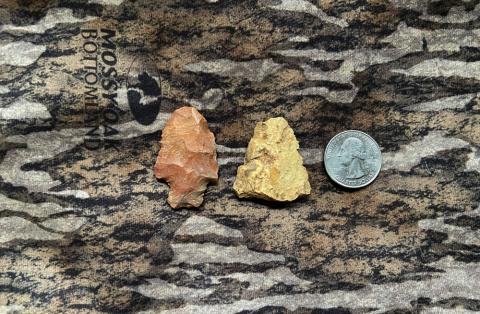Tony Peres of Great Falls, Montana, is new to the Mossy Oak ProStaff. His favorite critter to hunt is mule deer, but he also enjoys hunting turkeys, antelopes, white-tailed deer, elk and carp. “Since I shoot carp with a bow, I consider carp a critter I hunt. I started hunting when I was 12 years old, and I’m 46 now. My family moved back to Montana in 1992. I live in Great Falls and I hunt primarily with my bow, but I also do some gun hunting.”
The Secret to Finding and Taking Mule Deer in Montana
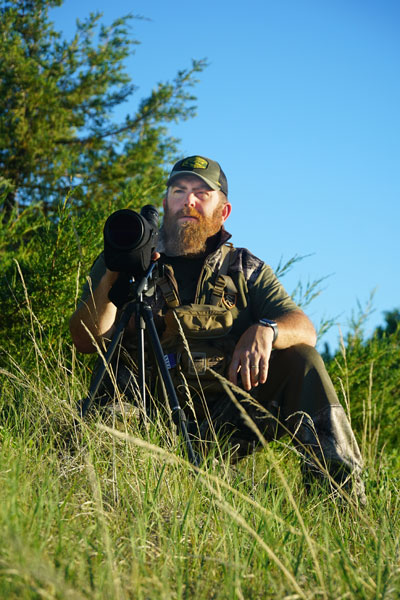 I believe the main secret to hunting mule deer successfully is spending a lot of time with your spotting scope and binoculars to be able to find the deer. I try to locate an area and work it, and work it and work it, which means putting in many hours and many days with my eyes and my optics. If you don’t learn anything about the mule deer from scouting, that’s like looking in an empty bucket and hoping to find a $100. I believe that the number-one most important ingredient, especially for taking a big mule deer, is to be patient and spend many hours glassing to find a mule deer to hunt.
I believe the main secret to hunting mule deer successfully is spending a lot of time with your spotting scope and binoculars to be able to find the deer. I try to locate an area and work it, and work it and work it, which means putting in many hours and many days with my eyes and my optics. If you don’t learn anything about the mule deer from scouting, that’s like looking in an empty bucket and hoping to find a $100. I believe that the number-one most important ingredient, especially for taking a big mule deer, is to be patient and spend many hours glassing to find a mule deer to hunt.
I use all Zeiss Optics. I absolutely love my Zeiss Conquest Gavia 85 spotting scope, and I mount it on a carbon tripod. Montana has plenty of places to hunt mule deer. You can hunt dark timber, you can hunt the Missouri Breaks, and you can hunt farmlands. But I primarily hunt what I classify as open country; I like to see a lot of land. I do a lot of lowland farm and coulee hunts, but I also hunt the Missouri River Breaks in eastern Montana, because there are hundreds and thousands of acres for public-land hunting there. I also hunt numbers of farmlands near Great Falls, Montana, where I live. I’ve met a lot of farmers and built trust with them. All I have to do to hunt their lands is make a phone call, and I can go hunting after work.
Once you find a mule deer buck you want to take, the next critical key is like the first: you must be very, very patient. Patience has been one of the toughest lessons I’ve had to learn. Learning to shoot accurately and making a shot with a bow isn’t nearly as difficult for me as being patient enough to get to the mule deer and wait on him to be in the right place for me to take the shot.
One of the mistakes most mule deer hunters make is getting prepared for the shot, which generally isn’t too difficult. But when you’re in the moment, and that big deer is in front of you, your blood pressure will climb, and your adrenaline will be high. You’ll often make mistakes, go too fast and end up being stupid - or at least that’s what happens to me. The most difficult part of mule deer hunting for me is trying to figure out where that mule deer is, the best direction to travel to get in close to the mule deer without them seeing or smelling me, and then being willing to commit to taking my boots off and hunting in my socks. You may have some slip-on, soft-soled shoes to get in close enough or quiet enough to get the shot. If you don’t take all the precautions to get in close to a mule deer, they’ll either hear, see or smell you, and then your hunt will be over.
When I hunt mule deer, I wear a very light boot from L.A Sportiva that’s ventilated, much like an early-season hiking boot but made of Vortex. These boots allow me to walk all day without getting hot, sweaty feet. When I get in close to a mule deer, I take my boots off and depend on my Darn Tough socks. I’ll probably wear these socks forever. When I am in my sock feet, I’m looking for cactus, rattlesnakes and sharp rocks. I try and pick where I’m going to take my next step before I put my foot down. I mainly get these socks from farm and ranch stores, but I’m beginning to see other stores carry them too. They’re made of a Merino wool blend – in thin socks and heavy socks.
My Biggest Mule Deer with a Bow
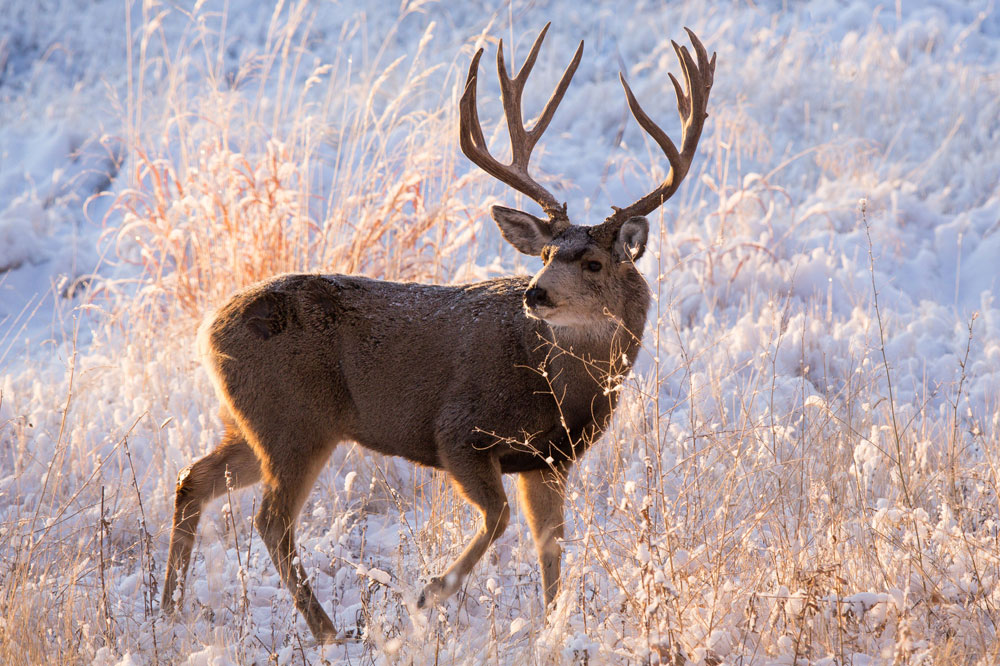
My best mule deer scored 176 inches, and I’ve harvested four or five bucks in that 170 class. I was hunting private land that a farmer had allowed me to hunt. His farm was at the base of the Highwoods Mountains range in central Montana, and his property wasn’t far from where my family homesteaded four generations back. I grew up hunting in some of that same country with its numbers of deep, nasty coulees, and I found some real big bucks on this property.
In 2020, I discovered a group of bachelor bucks when I was early scouting in July. I scouted this group of bachelor bucks for 20 days to learn where they were living, and where they were feeding and bedding. On September 20th, I finally took a buck after missing a bigger one earlier in the season. The buck I missed was in his bed when I took the shot, and as soon as I released the arrow, the buck stood up, and I missed him by the length of a short hair. There were 10 bucks in this group, and the biggest was about 180-190 Pope & Young. The buck that I eventually took I believed to be the little brother of the bachelor group buck because his antlers had all the same characteristics of the big buck. In September, the group of 10 bucks began to break up, and instead of seeing 10 bucks together, I’d only see one or two bucks at a time.
On the 2020 morning I took my buck, I got into the place where I thought this buck would be at 4 a.m. and laid down in the nearby grass. The grass was waist-high, and I thought the bucks would bed-down below me in a steep bank deep in a coulee. However, when the sun finally came up, I never saw a deer. Finally at 9 a.m., I spotted some does moving near me in the distance. Normally the bucks would come in to bed right at daylight, but on this day the does and the bucks were definitely late. The does finally moved about 1/2-mile away and went into a different drainage than the one where they always bedded. I didn’t have permission to hunt that drainage because it was on another landowner’s property. Since I didn’t have any cell service, I moved around until I got two bars on my cell phone. I looked up the landowner’s name who owned the coulee where the does had gone, got his phone number, called him up and told him where I’d seen the deer, and where they had gone. The landowner said, “You can hunt that coulee, but if you take that buck, don’t call me to come help you get the buck out. That’s a very deep coulee. I’m not going to come help you drag out that deer.”
Since my hunt occurred in September, the temperatures were in the 70-degree range. There was no wind. For that reason, I knew it was a take-your-boots-off and hunt-in-your-socks kind of day. Eventually, I spotted three bucks on the opposite side of the coulee from me, before they went down to the bottom of the coulee where I couldn’t see them anymore. I waited for an hour, thinking they would bed-down on the east side of the coulee, since I could see the west side of the coulee.
I had to make a 1/2-mile hike to cross the coulee and get on the other side. Once I felt like I was close to where they were bedded, I dropped my pack in the middle of a seeded wheat field, took my boots off and started sneaking toward the edge of the coulee. My heart was beating so fast and hard that I thought it might come up into my mouth. I knew the buck I was after was a big mule deer, but I didn’t know how big. I walked about two steps and used my binoculars to glass the coulee. The mule deer out here will dig beds into the side of these draws, so, when they lay down in their beds, they blend in so well with the terrain around them that they’re difficult to see. I was using 10x42 binoculars to pick apart every bush and piece of structure where those bucks could be.
Once I took a step just over the edge of the coulee, the bucks were right below me in a little finger ridge coming off the coulee. My range finder reported that the deer were 21 degrees below me, the bucks were in their bed and sound asleep, and they had no idea I was above them. Instead of three bucks, I now saw four. One of the bucks had his head up, chewing his cud. He spotted me, but for some reason he didn’t spook. I ranged the buck, and he was at 80 yards.
I’d shot competitive archery for many years, and I’d practiced often shooting out to 100 yards. I knew my equipment was stout enough to take that 80-yard shot due to my bow weight of 72-73 pounds. The sighting system was a Montana Black Golf Ascent Verdict 5-Pin Sight. I used my bottom pin because I could dial in the yardage with that pin, and shoot dead-on.
As I watched my arrow in flight, it dropped into the buck, right behind his front shoulder, went all the way through the buck and buried into the dirt where he’d been. Once he stood up, he broke the arrow off. He spun around and had blood coming out of both sides. He ran down a trail from the bottom of the coulee, but his legs began wobbling before he fell, rolled all the way to the bottom of the coulee and landed upside down in a dry creek bed. I went down and checked on the buck. Then I climbed out of the coulee and went to get my pack and my boots.
Once I returned to my buck, I paused for a minute to think about how lucky I was. I finally got the deer out of the creek bed and up to a flat spot to quarter him. I had enough cell service to call my wife and tell her, “I just took the biggest buck of my life,” and then my phone cut off. I then thanked the Good Lord for this opportunity and this day, quartered the buck up and made two trips back and forth to get the meat and the head out of the coulee. When I field dressed him, I found 4-6 inches of my arrow still in the buck. When we finally scored the deer, he scored 176 Pope & Young.
The Trophy Montana White-Tailed Buck
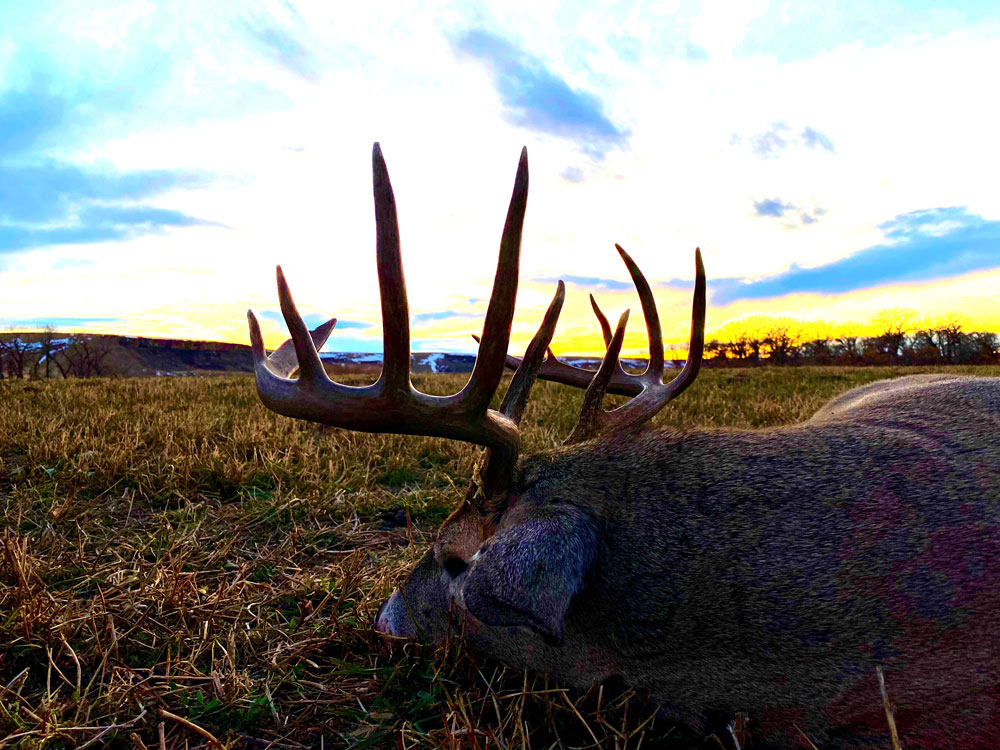
Montana has some very big white-tailed bucks because most people come to Montana to hunt mule deer, and even the locals prefer to hunt mule deer more than whitetails. I’m different because I enjoy hunting whitetails from a tree stand where I can sit still and quiet and watch the natural world happen. Occasionally, I’ll go out and hunt on a ranch a friend of mine has, and I’ll usually put out trail cameras to see which kind of white-tailed bucks are on the property.
Montana had about a week’s worth of rifle season left when I went out to the farm to see what kind of deer were on the property. I got up high on a hill and glassed the river bottom like I would when hunting mule deer. I knew that the whitetails generally funneled out of the river bottom and came out of the alfalfa bottom just before dark. Before last light, I saw two really nice white-tailed bucks chasing does. I decided to return the following afternoon, bring my rifle and hopefully get a favorable wind and take one of those bucks.
Two days before this hunt, I’d taken one of my buddies and his daughter out to this ranch. The daughter wanted to shoot a white-tailed doe. Just before dark, this beautiful, huge 4x4 whitetail stepped out into the alfalfa field. I looked over at the fellow we called “Preacher,” and I told him, “That big buck that just stepped out on the field is a really big whitetail. He’s coming toward us, and we’ve got about 2 minutes left of shooting light.” Preacher looked at his 15-year-old daughter and asked, “Do you want to shoot a white-tailed buck?” and she answered, “No, I want to shoot a doe.” Preacher then said, “You better look at this buck,” and as soon as she took her eyes out of the binoculars, the young lady said, “Yeah, I think I want to shoot that buck.”
Well when I heard those words, I was kind of heartbroken because this was a really nice whitetail, and I wanted to shoot him. Then I thought, “This is a special moment for this young lady and her dad, so I’m going to help her take this buck.” We put her pack on the ground and had her laying down in the snow to take the shot, using her pack as a brace for the rifle.
While we were getting her ready to take the shot, I learned that this young lady never had taken a shot at 300 yards before, and she was shooting a 6.5 Creedmoor. We coached her through the shot, and when the buck turned to the side toward her, she took the shot, and the buck dropped in the same tracks where he’d been standing. I ranged the shot, and the buck was at 320 yards. She was excited when she saw the buck go down, but then when we walked up to the buck, and she saw how big it was, she started shaking like a leaf. I really think I could have pushed her with my little finger, and she would have fallen over. Her dad was almost as excited as she was.
Miracle Montana Whitetail
Two days after the Preacher and his daughter had taken the big 4x4 whitetail that I’d planned to shoot, I went to the back side of that same property and spotted two, really nice white-tailed bucks coming out of the creek bottom and going out into the alfalfa field to feed. I decided that the next afternoon I’d try and get into a position to take one of those big whitetails. I planned to hike into the place where I wanted to take a stand by hiking down the river bottom.
When I finally arrived at the stand site where I wanted to be, I sat for five hours but saw nothing. I was getting really frustrated. There was only 30-40 minutes of daylight left, so I got up on my knees and started glassing an alfalfa field about 1000 yards long and 400-500 yards wide. I spotted a few does come out of the timber, but in my peripheral vision, I saw something move really fast. I swung my binoculars over there and spotted a doe running as hard as she could. I looked behind her and saw a big white-tailed buck I’d never seen before – nor did I have any trail-camera pictures of him. But I realized he was a good, big deer. I thought to myself, “You better shoot this buck because there are only a few days left in the season.”
I grabbed my rifle, brought it up to my shoulder and saw that the buck and doe had stopped right behind some trees. I moved over, got on my knees, set up shooting sticks and prepared to make the shot. I shoot a 6x24 magnification scope, and when I looked through that scope, I couldn’t see the deer. Then I realized my scope was on 24 power, so I grabbed my scope, and screwed it back to 12 power. I could see the deer, and the buck had started chasing the doe again. Suddenly, the buck stopped and looked right at me. I knew he couldn’t see me, but as soon as he stopped, I pulled the trigger. All the deer ran out of the field, and I couldn’t see my buck in my scope. My rifle was a Savage 110 High Country Bolt-Action Rifle in 6.5 PRC with Hornaday ammunition. I ranged the shot, and the buck was at 300 yards exactly. I shoot a lot at long range, and a 300-yard shot wasn’t a difficult shot for me to make.
I told myself, “I know I killed that deer,” but then I realized I didn’t hear that “whop!” that happens when the bullet hits the deer. I started second guessing myself and thinking maybe I had missed. Then I remembered that I’d seen all the deer run out of the field, but not this buck. I used my binoculars to glass the field one more time and walked toward the spot where I’d shot the buck. The field I was hunting wasn’t flat; it had little ridges and dips in it all the way across the field. When I had walked about 300 yards, I came out of one of these little dips and looked down to where I thought the buck should be. However, he wasn’t there. I ranged the trees from where I was, and I was 260 yards away from the tree line. I realized I hadn’t gone far enough to reach the spot where I’d shot the buck. I went down in this little swell and came up on the other side. Once I looked down in the next swell, I spotted the buck that was stone-cold dead. The buck was a main frame, 6x6 (12-point eastern count) and scored 148. He had 20-inch main beams, and I knew I’d never shot a whitetail that big in my entire life. Maybe by letting the young girl take the big 8-point I wanted to shoot, karma gave me a better buck than I ever had shot in my life.
Four Montana Antelope Bucks in 3 1/2 Hours
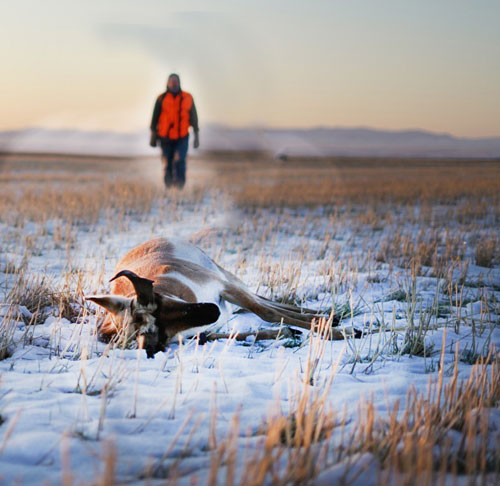
In Montana, we have to draw tags to take an antelope. But a rifle tag equals unbelievable antelope hunting. In Montana, you can put in for a party tag, which means if you draw that tag, everybody in your hunting party has the opportunity to take an antelope. I can’t remember which of my family members pulled the tag, but we all pitched in for this tag. I had a tag, as did my son, my dad and my wife. I have a farmer friend with a ranch just north of town, and I wanted to hunt there because there were few public lands to hunt in this area. Most of the land in that section of Montana was planted in agriculture.
When I talked to my friend, he said, “Yup! We’ve got antelopes. Bring your family, and come on, and I’ll try and find some antelopes for you to hunt.” The first day of antelope season, we pulled up to a field at 7 a.m. About 40 head of antelope were in that field. I told my son, “Get your gun, and let’s walk out toward that herd.” Before we got too close, the antelopes saw us and scattered. My son Hunter shot the first buck, and the buck hit the ground at 7:30 am. Our group took four antelopes by 11 a.m. on opening day of antelope season.
Where we hunt antelopes in Montana, there’s a lot of flat country. We drive county roads and glass. We try to get as close as possible on a two-track road, but sometimes we have to get out of the truck and hump it for a mile or two. This place is a special-draw area, which means there are a limited number of tags, and these antelopes don’t receive very much hunting pressure. You can drive a tractor almost right into the herd, but if they see you driving a truck 1/2-mile away, they’ll start running. Shortly after my son took his antelope, we spotted a buck just a little ways down the road, and my wife Jennifer shot the second antelope.
After we got those two antelopes loaded up, my buddy who owns the farm called and said, “Have you checked out this other field?” I answered, “No, we haven’t.” My friend then said, “There’s a two-track road that will take you to an old homestead and this field. Some antelopes have been hanging out by that homestead. I think you should check it out.” We drove the truck down the two-track road, and I got out of the truck to do some glassing. This land had a little bit of a roll to it, and I tried to reach the highest spot on the property to see the most land. Before I arrived at the high spot, I spotted a large herd of antelopes running right toward me. That herd came within 200 yards of me. I picked out the best buck, and as he was trotting parallel to me, I took the shot. I was shooting my 6.5 Creedmoor and aimed right at the tuft of hair on his neck. When I squeezed the trigger, he hit the dirt. His prongs were almost 16-inches tall, and I said, “That’s the biggest antelope I’ve ever taken in my life.” He fell in the CRP grass, and I was able to drive the truck right to him and load him up.
The only tag left unfilled was my dad Rus Peres. My 72-year-old dad has spinal stenosis, so he doesn’t get around very well. After we’d loaded up my antelope, we were driving back down the road we’d taken to the homestead. In Montana, you can’t shoot out of a motorized vehicle like a truck, a boat or an ATV. Before we could get back to the county road from the two-track road, I spotted a herd of antelopes standing out in the open. I stopped the truck and helped my dad get out of the truck. Dad saw a smaller buck in the herd and he said, “I’ll shoot that one.”
We opened the door, and Dad got his 250 shotgun he’d hunted with when he was a youngster. Dad said, “I’ve never shot at an animal that far away with this shotgun.” I quickly zoomed-in with my scope, handed my rifle to my dad and said, “Shoot him with my rifle!” Dad needed some time to get the eye relief on my rifle scope where he could see clearly through it. But finally he squeezed the trigger, and that antelope went down. I ranged the distance, and my dad had shot 280 yards. By 11 a.m., opening day of antelope season, our four hunters had four antelopes down and loaded in the truck between 7 – 11 a.m. That’s an antelope hunt none of us ever will forget!
Hunting Elk in Montana’s Missouri Breaks
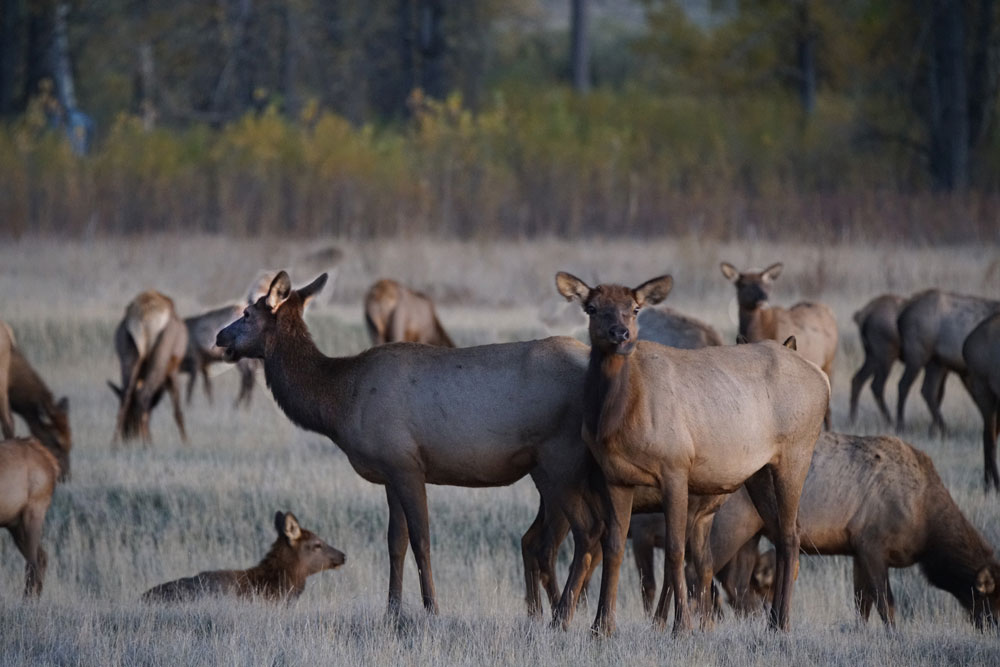
When I go elk hunting, I like to hunt the Missouri River Breaks in eastern Montana. There are only a few, two-track roads that run through this land that’s very dry and eroded. When rain falls, the ground turns into gumbo-like mud. You can get a bulldozer stuck on flat ground in some of these areas. I tell folks the Missouri Breaks are super-dry country, and if you get drops of rain, it all turns into gumbo mud. The region looks like mountainous country; however, it’s actually flat and has deep coulees in it, as well as sage, CRP grass and timber pockets in these big, nasty coulees. That’s where you’ll find your elk.
The Missouri River runs through this country, and the elk don’t hesitate to swim back and forth through the river. Out in the middle of the Missouri River are islands. My friends and I like to hunt a 5-mile-long island there. We have to use a boat to go about 100 yards over to an island. I have an old jet boat that we take to the river to get to the island. I have some friends who have been hunting this island for 20 years, and this island is a special-draw area for a bow tag.
In 2020, I drew an archery tag to hunt the island, as did some of my friends. When we reached the island, we heard a few bulls, but the bulls didn’t want to come to us. Even though this was a special archery unit, quite a few tags had been given out. We knew the elk on this island were called to quite a bit, and were somewhat call-shy. We brought two ladder stands with us. I was hunting with my buddy Shane Griffin. When we loaded-up the jet boat, we drove to the head of the island, cut the motor off and drifted, hoping to hear elk bugling. Once we heard a couple bugles, we went to the point of the island and anchored our boat.
Willows surrounded the island, so we had to wade through willows to reach the island. However, once we got onto the island, I saw big, flat, beautiful grass fields with tall grass that came up to my waist. Although we glassed the grass fields looking for the two bulls that had bugled, we never saw them. Since we were on the island at first light, the grass was soaking wet with dew. We were soaking wet from the waist down and decided to go back to the boat, move to the other end of the island and hope to hear elk bugle there.
When we reached the other end, we anchored the boat in the willows. Before we even climbed out of the boat, we heard five bugling elks. However, the willows were so thick we couldn’t see the bulls. We tried to work our way through the willows and make as little noise as possible. We thought the elk were bedded-down somewhere close to the willows. Shane is one of these fellows who when he sets his mind to do something, he’ll do it, regardless of the obstacles he may encounter. Shane crawled up on top of a big deadfall and whispered loudly, “I can see an elk in the back of this field. No, there are five of them.” I got up on top of the deadfall and spotted a spike bull bedded only 45 yards away with about 10 cows. Shane said, “If you want to take an elk, when that spike stands up, shoot him!” Knowing I was leaving in 2 days, I agreed.
I had an arrow nocked, and I waited on the spike to stand up, but he never did. In only a few minutes, a bull bugled. Every one of the elk we were looking at, stood up and started walking to where they’d heard this bull bugle. All the elk would be coming down this little trail right out in front of me, and I decided if the spike showed up on that trail, I’d shoot him. In only a few minutes, the cows came down the trail, and I counted 10 cows before the spike stepped out. I drew my bow and released the arrow. The shaft flew right over that spike’s back. I had ranged the cows before I took the shot at the bull. I’d ranged him at 45 yards when he was bedded-down. But the elk now was only at 32 yards. I made a great shot and would have killed the bull if he’d been at 45 yards instead of 32. Shane looked at me and said, “Man! I thought you could shoot that bow.” To which I answered, “I made a perfect 45-yard shot. I just didn’t know the elk was that close.”
Next we walked about 100 yards into the center of the island and saw a herd of about 20 more elk – all cow elk about 20 yards away. We passed on the cows and went more toward the center of the island where we saw five or six bulls with a bunch of cows. The herd bull had most of the cows herded up in the back of this field. We called some, and the elk bugled to us, but they wouldn’t come. Since this field was so open, we knew we couldn’t go to the bulls without all the elk spotting us. We pulled out, returned to camp and decided those elk weren’t going to move. Our best chance for taking a bull was to set up close to where these bulls were feeding.
We loaded up our two, 15-foot ladder stands, went back down the river to the island, drug the stands through the willows and pinpointed a couple of trees in the center of the island that would be suitable for the two tree stands we had. By the time we got our tree stands set up, the time was 2 p.m., and we were drenched in sweat. We returned to the boat, made lunch and then went back to hunt about 4:30 p.m. I hadn’t been in my stand more than 45 minutes when I heard an elk calf bawling that eventually came and stood beside my tree stand’s ladder. I started to hear cow calls and a herd of elk coming toward me. I never understood why the calf was out in front of the herd.
Next I saw, elk 50-60 yards from my stand, moving into this opening my stand was facing. I heard a bull bugle at the back of the herd. Probably 30 cows passed in front of me on the same trail, and then I spotted a bull. The cows were standing about 40 yards in front of me nibbling on some grass. Next I saw a cow trip and fall in front of me, and the commotion she created when she fell scared all the other elk. The bull ran, and when he stepped 50 yards in front of me, I whistled, and the bull stopped. I was already at full draw, so I released the arrow. The bull ran a little way, stopped and started walking again. I could see my arrow, and that I’d made a perfect shot. The bull kept walking into the willows, and about 10 minutes later, I heard a crash. The bull had fallen. Shane and I went out into this little grassy field where I’d shot the bull, found the blood trail and followed it into the willows. We only went about 200 yards before we located my bull.
The bull was a 6x6 and scored 310 inches. That was my first bull elk I’d ever taken with my bow. We didn’t have our packs, and we knew that we had to return to the boat, get our packs and come back to butcher the bull. I put my elk tag on the bull’s antlers. We got back to camp at 10:30 p.m., grabbed my pack, and near to us were some other hunters from Minnesota. They offered to get in their boat and come help us get my elk out. We had five men with five packs and two boats, and we were able to quarter the elk and bring the meat, head, and cape back to camp by 1 a.m.
















